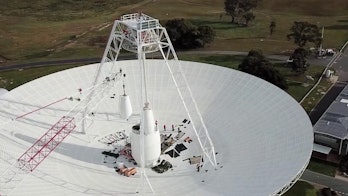AFTER MONTHS OF THE SILENT TREATMENT, NASA has finally reconnected with one of its longest running missions.
The Voyager 2 spacecraft has been roaming the cosmos for more than 40 years, all the while staying in touch with a diligent team of engineers in ground control. But in March of this year, NASA hung up the line.
The space agency left the spacecraft to spend a lonely few months in space in order to upgrade their communication system. Flying some 11.5 billion miles away from Earth, Voyager 2 was left to its own devices in mid-March.
But on October 29, NASA briefly reconnected. And, thankfully, Voyager 2 gleefully answered the call.
Voyager 2 is a vital scientific mission and one of the furthest manmade objects from Earth — so far it has left the Solar System entirely. To communicate with the spacecraft, NASA relies on a system called the Deep Space Network (DSN) antennas.
The system came to be when NASA launched its first ever satellite, Explorer 1, in 1958. The DSN is used to communicate with an average of 30 spacecraft every day. It runs 24 hours a day, 365 days a year, and is spread out across three sites in the United States, Australia, and Spain.
The DSN is reliable. But it is also more than 70 years old.

As the space agency gears up for a slew of new missions to the Moon and Mars, all launching in the next few years, the DSN is due for a much needed upgrade.
NASA started this crucial work with an antenna dubbed Dss43. It is 230-feet-wide, about the size of a 20-story building, and is located in Canberra, Australia.
Dss43 has been operational for 48 years — and some of its parts, including the transmitter used to communicate with Voyager 2, had never been upgraded.
But to safeguard the antenna's next four decades of service (hopefully), NASA has upgraded Dss43's heating and cooling equipment, power supply equipment, and other electronics.
Friday's brief call to Voyager 2 was the first test of the new equipment.
"What makes this task unique is that we're doing work at all levels of the antenna, from the pedestal at ground level all the way up to the feedcones at the center of the dish that extend above the rim," Brad Arnold, the DSN project manager at NASA's Jet Propulsion Lab in Southern California, said in a statement. "This test communication with Voyager 2 definitely tells us that things are on track with the work we're doing."
In the test, NASA's mission operators sent a series of commands to Voyager 2 for the first time since the radio antenna went offline in mid-March, and the spacecraft confirmed that it had received the signal and went on to execute the commands.
Unfortunately for the lonely craft, NASA is going to hang up the line again. Dss43 will not be fully back online until February, 2021. Voyager 2 will have to face a few more months alone. That's worrying for the mission's engineers on the ground, too.
"Having the antenna down for one year is not an ideal situation for Voyager or for many other NASA missions," Philip Baldwin, operations manager for NASA's Space Communications and Navigation (SCaN) Program, said in statement. "The agency made the decision to conduct these upgrades to ensure that the antenna can continue to be used for current and future missions. For an antenna that is almost 50 years old, it's better to be proactive than reactive with critical maintenance."
In January 2020, Voyager 2 suffered a slight glitch, when its software shut down one of its science instruments unexpectedly. NASA’s ground team of engineers worked round the clock to get the spacecraft up and running to its normal operations once again by sending commands up to the craft. Because of its distance, each command took about 17 hours to reach Voyager 2. With no communication line, any fault with the craft that occurs during the downtime would be missed.
Voyager 2 is on a joint mission with another craft, Voyager 1, to provide scientists with a unique view of our own Solar System, looking at it from the outside in.
Both spacecraft began their journey in 1977, and the speedier twin Voyager 1 made the jump into interstellar space in 2011, before it was followed by Voyager 2 in 2018.
Initial results from the mission published in the journal Nature in November, 2019 describe how the craft have given scientists a pretty good idea of the shape of the heliosphere — the bubble that the Sun forms around itself and separates it from outer space.
The mission still has about five years left in its designated timeline.



No comments:
Post a Comment